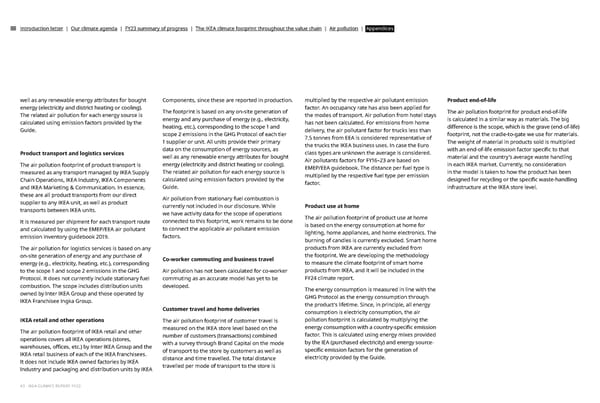Introduction letter | Our climate agenda | FY23 summary of progress | The IKEA climate footprint throughout the value chain | Air pollution | Appendices well as any renewable energy attributes for bought Components, since these are reported in production. multiplied by the respective air pollutant emission Product end-of-life energy (electricity and district heating or cooling). The footprint is based on any on-site generation of factor. An occupancy rate has also been applied for The air pollution footprint for product end-of-life The related air pollution for each energy source is the modes of transport. Air pollution from hotel stays calculated using emission factors provided by the energy and any purchase of energy (e.g., electricity, has not been calculated. For emissions from home is calculated in a similar way as materials. The big heating, etc.), corresponding to the scope 1 and Guide. delivery, the air pollutant factor for trucks less than di昀昀erence is the scope, which is the grave (end-of-life) scope 2 emissions in the GHG Protocol of each tier 7.5 tonnes from EEA is considered representative of footprint, not the cradle-to-gate we use for materials. 1 supplier or unit. All units provide their primary the trucks the IKEA business uses. In case the Euro The weight of material in products sold is multiplied data on the consumption of energy sources, as Product transport and logistics services class types are unknown the average is considered. with an end-of-life emission factor speci昀椀c to that well as any renewable energy attributes for bought Air pollutants factors for FY16–23 are based on material and the country's average waste handling The air pollution footprint of product transport is energy (electricity and district heating or cooling). EMEP/EEA guidebook. The distance per fuel type is in each IKEA market. Currently, no consideration measured as any transport managed by IKEA Supply The related air pollution for each energy source is multiplied by the respective fuel type per emission in the model is taken to how the product has been calculated using emission factors provided by the Chain Operations, IKEA Industry, IKEA Components factor. designed for recycling or the speci昀椀c waste-handling and IKEA Marketing & Communication. In essence, Guide. infrastructure at the IKEA store level. these are all product transports from our direct Air pollution from stationary fuel combustion is supplier to any IKEA unit, as well as product currently not included in our disclosure. While Product use at home transports between IKEA units. we have activity data for the scope of operations It is measured per shipment for each transport route connected to this footprint, work remains to be done The air pollution footprint of product use at home and calculated by using the EMEP/EEA air pollutant to connect the applicable air pollutant emission is based on the energy consumption at home for emission inventory guidebook 2019. factors. lighting, home appliances, and home electronics. The burning of candles is currently excluded. Smart home The air pollution for logistics services is based on any products from IKEA are currently excluded from on-site generation of energy and any purchase of Co-worker commuting and business travel the footprint. We are developing the methodology to measure the climate footprint of smart home energy (e.g., electricity, heating, etc.), corresponding to the scope 1 and scope 2 emissions in the GHG Air pollution has not been calculated for co-worker products from IKEA, and it will be included in the Protocol. It does not currently include stationary fuel commuting as an accurate model has yet to be FY24 climate report. combustion. The scope includes distribution units developed. The energy consumption is measured in line with the owned by Inter IKEA Group and those operated by GHG Protocol as the energy consumption through IKEA Franchisee Ingka Group. the product's lifetime. Since, in principle, all energy Customer travel and home deliveries consumption is electricity consumption, the air IKEA retail and other operations The air pollution footprint of customer travel is pollution footprint is calculated by multiplying the The air pollution footprint of IKEA retail and other measured on the IKEA store level based on the energy consumption with a country-speci昀椀c emission factor. This is calculated using energy mixes provided number of customers (transactions) combined operations covers all IKEA operations (stores, with a survey through Brand Capital on the mode by the IEA (purchased electricity) and energy source- warehouses, o昀케ces, etc.) by Inter IKEA Group and the IKEA retail business of each of the IKEA franchisees. of transport to the store by customers as well as speci昀椀c emission factors for the generation of It does not include IKEA owned factories by IKEA distance and time travelled. The total distance electricity provided by the Guide. Industry and packaging and distribution units by IKEA travelled per mode of transport to the store is 43 - IKEA CLIMATE REPORT FY23
 IKEA CLIMATE Report FY23 Page 42
IKEA CLIMATE Report FY23 Page 42 